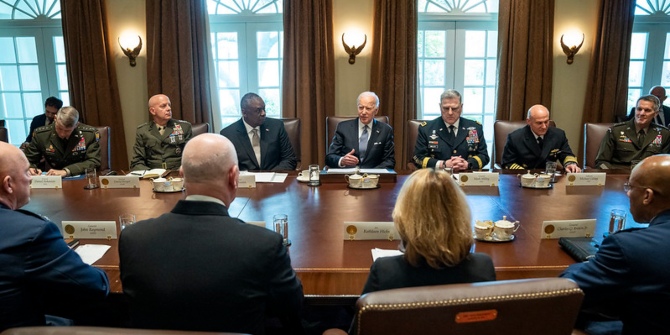 One of Donald Trump’s signature policies is to “build a wall” in order to better secure the border with Mexico. Susannah Crockford has spent nearly two years in Arizona conducting an ethnographic study; many in the area feel that constructing the wall is unnecessary. She writes that the real function of the wall is not to keep people out, but to serve as a symbol to mostly white, ageing conservatives, that President Trump will keep them safe.
One of Donald Trump’s signature policies is to “build a wall” in order to better secure the border with Mexico. Susannah Crockford has spent nearly two years in Arizona conducting an ethnographic study; many in the area feel that constructing the wall is unnecessary. She writes that the real function of the wall is not to keep people out, but to serve as a symbol to mostly white, ageing conservatives, that President Trump will keep them safe.
One of the major platforms of Donald Trump’s campaign was to build a wall along the whole length of the US-Mexico border. Within five days of his inauguration he signed an executive order promising just that. While it may seem like a rational, albeit conservative, policy to address the issue of undocumented migration, the practicality of building a wall is far more complex. It also sends a strong message about what sort of nation America is and who is allowed to go there.
The idea that building a 50ft wall along the border with Mexico will improve US security is belied by the social reality of the border. There are already 650 miles of wall and fencing on the 1,900 mile border. The new wall would extend this to cover an additional 1,000 miles, with the remainder being terrain such as desert and mountains considered too difficult to traverse. The extension is a re-enactment of the Bush-era Secure Fence Act of 2006 which built the existing wall at a cost of $7 billion.
Since the imposition of the “Prevention Through Deterrence” policy in the 1990s, the US-Mexico border has become the most militarised border between two peacetime nations. This policy focuses the efforts of the Border Patrol on densely populated and easy to cross areas. A wide array of technological surveillance and fortification is already used including SUVs, drones, thermal imaging cameras, motion sensors, infrared cameras, ground sensors, surveillance towers, and even a blimp. Jason de León of the Undocumented Migrant Project likens the Border Patrol’s use of expensive high-tech gadgets to magical fetishes. And like talismen, the weapons of the Border Patrol operate to ward off the unwanted.
The effect of this policy has been to funnel crossings to the dangerous mountain and desert ranges of Southern Arizona. This has decreased the number of attempted border crossings while increasing the number of deaths of migrants attempting to cross. With crossings increasingly occurring over the most dangerous terrain; the border area has precipitated a humanitarian crisis. This terrain would still be open under Trump’s plan, as it is not possible to build a 50ft wall there. The wall will therefore increase the number of migrants crossing in hostile terrain. The result will be that more people will die.
This is because without a meaningful attempt to address the root causes of migration, people will still cross. Smuggling will also continue with drugs going into the US and firearms going into Mexico. As former Arizona governor and Obama’s Secretary of Homeland Security, Janet Napolitano said: “You show me a 50-foot wall and I’ll show you a 51-foot ladder at the border. That’s the way the border works”. Drugs and other contraband are propelled over the current fence with catapults and t-shirt cannons; car jacks are used to lift it up while people crawl under; cars are jumped over from ramps; cartels are well known for digging multiple tunnels to go underneath. Beyond this situation, there remains the fact that between one-third and one-half of undocumented migrants to the United States do not illegally cross over the southern border, they overstay their visas.
For my PhD research, I spent between July 2012 and April 2014 in the Northern Arizona towns of Sedona and Valle. As part of this ethnographic research, I spoke to more 100 local residents. I recently got in touch with four of my informants to ask them specifically what they thought of the wall. In general, they are opposed to constructing a bigger wall on the border. For Matthew, the main problem is cost and ineffectiveness: “I don’t think in the end any wall will stop illegals…the question we have to ask is do illegals cause $20 billion+ in harm to warrant the expense of a complete wall.” The question of who is going to pay has been recurrent since Trump first proposed the new wall; and despite his assertion, it is probably not going to be Mexico. Estimates range upwards of $21.6 billion. Much of the border land in Texas is private property, so this would have to be purchased or seized. It also divides the Tohono O’Odham Nation, and the tribe has already stated it will not allow the wall to be built on their land. The wall could also have a devastating environmental impact on the border region.

Ana responded with “sadness and skepticism”. She told me, “My Mexican-American roots have always grounded me to be faithful in Our Lady of Guadalupe. My family has lived on this land in Phoenix, Arizona, for three generations…I have always been taught to help those in need, and the President’s proposed border wall is contrary to what I have been taught as part of my faith in God. The border wall is in the planning stages and I am still of the belief that it won’t happen. When I ask my family and others in the Latino community, the overall sentiment is outrage and fear. I know Mexican families that have been separated; daughters from mothers and sons from fathers. The current president only guarantees more of this type of action against non-Americans…After overcoming the sadness of the proposed wall, I moved onto the feeling of insecurity, and I have talked to many Latinos who felt or still feel the same way. How can I feel unsafe in a state where me and my family have lived for over 100 years?”
Melanie also reflected on the message the wall would send: “We hear the echo of the Berlin Wall that fell joyfully…[People say] ‘Mexico’s problems aren’t us’. But they are, and to think they are no longer a problem with a wall between us is untrue. It is unjust…It is not sound knowledge, but a cash cow worship; and the Tower of Babel will play out again perhaps until a great war returns to remind us how much we had to gain in our peace”.
The people I know in Arizona reflect recent research that shows the majority of Americans do not see building a wall as a priority in immigration policy. So why build one? The wall is a symbol, there for the people already in the US who feel besieged. But it does more than assuage the fears of the anti-immigrant Trump-supporting minority; it is a way of telling them they are the chosen people. They are the real Americans, fortified and safe within their castle. Like many of Trump’s policies, it is playing to a very specific white, rural, ageing, conservative audience that is afraid of America’s changing demographic and their own loss of pre-eminence. The wall is an exclusionary symbol, a monument to fear and ego; it says who is allowed in America and who is not; who counts as American and who does not.
Featured image: “Wellton Border Patrol Station Construction” by U.S. Army Corps of Engineers is licensed under CC BY 2.0
Please read our comments policy before commenting.
Note: This article gives the views of the author, and not the position of USAPP – American Politics and Policy, nor the London School of Economics.
Shortened URL for this post: http://bit.ly/2lHIgMZ
_________________________________
 Susannah Crockford- LSE Department of Anthropology
Susannah Crockford- LSE Department of Anthropology
Susannah Crockford is a PhD candidate in the anthropology department at the London School of Economics. She spent almost 2 years living in Northern Arizona, studying religion and political economy. Her fieldwork centred on the small-town of Sedona and the rural area adjacent to the south rim of the Grand Canyon. Previously, she completed degrees at the University of Cambridge and the University of Amsterdam.







This is just an opinion piece that really says nothing more that ‘I think the wall in unnessesary’, but lacks any real proof or statistical data as to why that might be so.
This is GREAT.
Concerning the real problem of Immigration. What exactly is that and who do you blame it on? He think you can get the leaders of these countries the migrants are coming from to be more caring for their people or offer them better solutions to their living conditions? I don’t think that’s going to happen